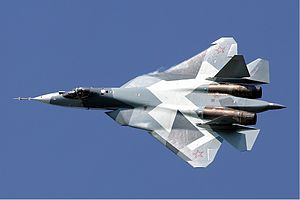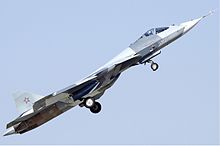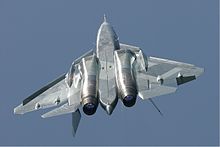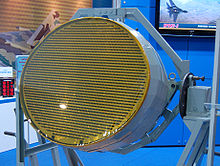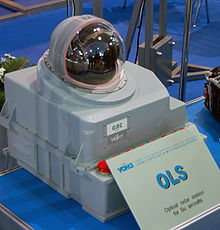- Sukhoi PAK FA
-
PAK FA PAK FA T-50 Role Stealth multirole fighter National origin Russia Manufacturer Sukhoi First flight 29 January 2010[1][2][3] Introduction 2016 (planned)[4][5][6][7] Status Test flight / pre-production Primary user Russian Air Force Number built 3 flown [1][2] Program cost US$8–10 billion (est.)[8][9][10] Unit cost US$47.5-57 million[11] Variants Sukhoi/HAL FGFA The Sukhoi PAK FA (Russian: Перспективный авиационный комплекс фронтовой авиации, Perspektivny aviatsionny kompleks frontovoy aviatsii, literally "Prospective Airborne Complex of Frontline Aviation") is a twin-engine jet fighter being developed by Sukhoi OKB for the Russian Air Force. The Sukhoi T-50 is the prototype for PAK FA.[12] The PAK FA is one of only a handful of stealth jet programs globally. [13]
The PAK FA, when fully developed, is intended to be the successor to the MiG-29 and Su-27 in the Russian inventory and serve as the basis of the Sukhoi/HAL FGFA being developed with India.[14][15] A fifth generation jet fighter, the T-50 performed its first flight 29 January 2010.[3][16] Its second flight was on 6 February and its third on 12 February 2010. As of 31 August 2010, it had made 17 flights and by mid-November, 40 in total. The second prototype was to start its flight test by the end of 2010, but this was delayed until March 2011.[17][18][19][20][21]
Sukhoi director Mikhail Pogosyan has projected a market for 1,000 aircraft over the next four decades, which will be produced in a joint venture with India, 200 each for Russia and India and 600 for other countries.[22] He has also said that the Indian contribution would be in the form of joint work under the current agreement rather than as a joint venture.[23] The Indian Air Force will "acquire 50 single-seater fighters of the Russian version" before the two seat FGFA is developed.[24] The Russian Defense Ministry will purchase the first 10 aircraft after 2012 and then 60 after 2016.[25][26] The first batch of fighters will be delivered with current technology engines.[27] Ruslan Pukhov, director of the Centre for Analysis of Strategies and Technologies, has projected that Vietnam will be the second export customer for the fighter.[28] The PAK-FA is expected to have a service life of about 30–35 years.
Contents
Development
In the late 1980s, the Soviet Union outlined a need for a next-generation aircraft to replace its MiG-29 and Su-27 in frontline service. Two projects were proposed to meet this need, the Sukhoi Su-47 and the Mikoyan Project 1.44. In 2002, Sukhoi was chosen to lead the design for the new combat aircraft.[29]
The Tekhnokompleks Scientific and Production Center, Ramenskoye Instrument Building Design Bureau, the Tikhomirov Scientific Research Institute of Instrument Design, the Ural Optical and Mechanical Plant (Yekaterinburg), the Polet firm (Nizhniy Novgorod) and the Central Scientific Research Radio Engineering Institute (Moscow) were pronounced winners in the competition held in the beginning of 2003 for the development of the avionics suite for the fifth-generation airplane. NPO Saturn has been determined the lead executor for work on the engines for this airplane.
The Novosibirsk Chkalov Aviation Production Association (NAPO Chkalov) has begun construction of the fifth-generation multirole fighter. This work is being performed at Komsomol'sk-on-Amur together with Komsomolsk-on-Amur Aircraft Production Association; the enterprise's general director, Fedor Zhdanov reported during a visit to NAPO by Novosibirsk Oblast's governor Viktor Tolokonskiy on 6 March 2007. "Final assembly will take place at Komsomol'sk-on-Amur, and we will be carrying out assembly of the fore body of this airplane", Zhdanov specified.
On 8 August 2007, Russian Air Force Commander Alexander Zelin was quoted by Russian news agencies that the development stage of the PAK FA program is now complete and construction of the first aircraft for flight testing will now begin.[30] Alexander Zelin also said that by 2009 there will be three fifth-generation aircraft ready. "All of them are currently undergoing tests and are more or less ready", he said.[31] In the summer of 2009 the design was approved.[29]
On 11 September 2010, it was reported that Indian and Russian negotiators had agreed on a preliminary design contract that would then be subject to Cabinet approval. The joint development deal would have each country invest $6 billion and take 8 to 10 years to develop the FGFA fighter.[32] The agreement on the pre-design of the fighter was to be signed in December 2010.[33] The preliminary design will cost $295 million and will be complete within 18 months.[34]
On 17 August 2011, it was reported by Russian state-run media that the Sukhoi T-50 aircraft cost Russia and India $6 billion to develop, with India shouldering about 35% of the cost.[35]
On 17 August 2011, Russian Air Force chief says the Sukhoi T-50 will enter service in 2014-2015. "We will receive a T-50 prototype in 2013," Russian Air Force commander-in-chief General Alexander Zelin told reporters. "Mass produced aircraft will not arrive until 2014-2015."[36]
Former deputy defense minister Vitaly Shlykov has cast doubt on the industrial capacity of Russia to produce the aircraft in significant numbers.[37]
Flight testing
On 28 February 2009, Mikhail Pogosyan announced that the airframe for the aircraft was almost finished and that the first prototype should be ready by August 2009.[38] On 20 August 2009, Sukhoi General Director Mikhail Pogosyan said that the first flight would be by year end. Konstantin Makiyenko, deputy head of the Moscow-based Centre for Analysis of Strategies and Technologies said that "even with delays", the aircraft would likely make its first flight by January or February, adding that it would take 5 to 10 years for commercial production.[39]
The maiden flight had been repeatedly postponed since early 2007 as the T-50 encountered unspecified technical problems. Air Force chief Alexander Zelin admitted as recently as August 2009 that problems with the engine and in technical research remained unsolved.[40]
On 8 December 2009, Deputy Prime Minister Sergei Ivanov announced that the first trials with the fifth-generation aircraft would begin in 2010.[41] The testing, however, has commenced earlier than stated, with the first successful taxiing test taking place on 24 December 2009.[42][43][44]
The aircraft's maiden flight took place on 29 January 2010 at KnAAPO's Komsomolsk-on-Amur Dzemgi Airport; the aircraft was piloted by Sergey Bogdan (Сергей Богдан) and the flight lasted for 47 minutes.[3][45][46][47]
A second airframe was first planned to join the flight testing in the fourth quarter of 2010 but was postponed. On 3 March 2011 a second prototype was reported to have made a successful 44 minute test flight.[17] These first two aircraft will lack radar and weapon control systems, while the third and fourth aircraft, to be added in 2011, will be fully functional test aircraft.[48] On 14 March 2011, the aircraft achieved supersonic flight at a test range near Komsomolsk-on-Amur in Siberia.[49]
The T-50 was displayed publicly for the first time at the 2011 MAKS Airshow. Russian Prime Minister Vladimir Putin was in attendance.[50][51]
In June 2011, an unauthorized video was made of the Sukhoi PAK FA in flight displaying a variety of acrobatic moves.[52]
On August 21, 2011 during a take-off run at the MAKS Airshow, a brief flame appeared out of the right-hand engine before liftoff due to a sensor malfunction. The takeoff was aborted, braking parachutes were deployed and the aircraft returned to its park position under its own power.[citation needed][importance?]
On 3 November 2011, The PAK FA program achieved it's 100th flight.[53]
The T-50-3 prototype is expected to be the first prototype to fly with an AESA radar by the end of 2011.[54] On November 22, 2011 the third prototype T-50-3 had it's first flight from KnAAPO's airfield in Komsomolsk-on-Amur, piloted by Hero of the Russian Federation Sergey Bogdan. The aircraft spent little more than an hour in the air , and it was subjected to basic stability and powerplant checks.[55]
Navalized Sukhoi T-50 PAK FAs will be deployed on the Russian aircraft carrier Admiral Kuznetsov and future Russian aircraft carriers.[56] There will be a competition between the Sukhoi, Mikoyan and Yakovlev design bureaus to choose the new naval aircraft.[57]
Light fighter
Alexei Fedorov has said that any decision on applying fifth generation technologies to produce a smaller fighter (in the F-35 range) must wait until after the heavy fighter, based on the T-50, is completed.[58]
Design
Although most of information about the PAK FA is classified, it is believed from interviews with people in the Russian Air Force and Defense Ministry that it will be stealthy,[9] have the ability to supercruise, be outfitted with the next generation of air-to-air, air-to-surface, and air-to-ship missiles, incorporate a fix-mounted AESA radar with a 1,500-element array[59] and have an "artificial intellect".[60]
According to Sukhoi, the new radar will reduce pilot load and the aircraft will have a new data link to share information between aircraft.[61]
Composites are used extensively on the T-50 and comprise 25% of its weight and almost 70% of the outer surface.[48] It is estimated that titanium alloy content of the fuselage is 75%. Sukhoi's concern for minimizing radar cross-section (RCS) and drag is also shown by the provision of two tandem main weapons bays in the centre fuselage, between the engine nacelles. Each is estimated to be between 4.9-5.1 m long. The main bays are augmented by bulged, triangular-section bays at the wing root.[62]
The Moskovsky Komsomolets reported that the T-50 has been designed to be more maneuverable than the F-22 Raptor at the cost of making it less stealthy than the F-22.[63] One of the design elements that have such an effect is the Leading Edge Vortex Controller (LEVCON).
Avionics
The PAK FA SH121 radar complex includes three X-Band AESA radars located on the front and sides of the aircraft. These will be accompanied by L-Band radars on the wing leading edges.[64][65] L-Band radars are proven to have increased effectiveness against very low observable (VLO) targets which are optimized only against X-Band frequencies, but their longer wavelengths reduce their resolution. However the initial prototypes will use legacy passive electronically scanned array radar.[66][verification needed]
The PAK FA will feature an IRST optical/IR search and tracking system, based on the OLS-35M which is currently in service with the Su-35S.[citation needed]
Hindustan Aeronautics Limited will reportedly provide the navigation system and the mission computer.[63][dubious ]
Engines
PAK FA was expected to use a pair of Saturn 117S engines on its first flights. The 117S (AL-41F1A) is a major upgrade of the AL-31F based on the AL-41F intended to power the Su-35BM, producing 142 kN (32,000 lb) of thrust in afterburner and 86.3 kN (19,400 lb) dry. In fact, PAK FA already used a completely new engine 117 (AL-41F1) in its first flight, as stated by NPO Saturn.[67] The engine is not based on the Saturn 117S
The 117 (AL-41F1) is a new 5th generation engine custom built for Russia’s fifth-generation stealth fighter jet PAK-FA according to Sukhoi General Director Mikhail Pogosyan. Mikhail Pogosyan has clarified that claims that fifth-generation fighter allegedly has an old engine are wrong. Such claims are made by people with limited knowledge, he said. Though most parameters of the new 5th Gen Engine remains classified General Director Mikhail Pogosyan provided some information on the new engine, The engine thrust was enlarged by 2.5 tonnes when compared with the AL-31 engine, while the engine weight was cut by 150 kilograms. That allowed the new jet to supercruise i.e. move at a supersonic cruise speed without the use of after burner. [68]
The Saturn Research and Production center made digitally controlled system (FADEC) of Project 117 Engine. The new engine produces 33,000 lbs (147 kN) of thrust in afterburner has a Dry weight of 1420 kilogram and T:W ratio of 10.5:1[69]
Mikhail Pogosyan further mentioned that this engine (117) meets the client’s (Russian AirForce) requirements. This is not an intermediate product made particularly for test flights. The engine will be installed in production PAK-FA fighter which will be supplied to the Russian Air Force and prospective foreign clients he said.[70] The engine generates a larger thrust and has a complex automation system, to facilitate flight modes such as maneuverability. It is expected that each engine will be able to independently vector its thrust upwards, downward or side to side. Vectoring one engine up with the other one down can produce a twisting force. Therefore the PAK FA would be the first fifth generation fighter with full 3-D thrust vectoring along all three aircraft axes: pitch, yaw and roll. These engines will incorporate infrared and RCS reduction measures.[71][72]
Armament
The PAK FA has a reported maximum weapons load of 7,500 kg.[73] It has an apparent provision for a cannon (most likely GSh-301). It could possibly carry as many as two 30 mm cannons.[27] It has two internal bays estimated at 4.6-4.7 metres by 1-1.1 metres.[74] Some sources suggest two auxiliary internal bays for short range AAMS and six external hardpoints.
Two Izdeliye 810 Extended beyond visual range missiles per weapons bay. Multiple Izdeliye 180 / K77M beyond visual range missiles. K74 and K30 within visual range missiles can also be carried.[74] Two KH38M or KH58 USHK air-to-ground missiles per weapons bay. Multiple 250–500 kg precision guided bombs per weapons bay,[74] with a maximum of 10 bombs in internal bays.[73] Other possible loads include one 1,500 kg bomb per weapons bay or two 400 km+ range anti-AWACS weapons on external hardpoints.[75]
Operational history
Testing
The first flight video shows that PAK FA has no conventional rudders, its vertical tails are fully movable.[76] This special tail fin design is mechanically similar to V-tails used by the Northrop YF-23 in 1990s,[77] but is supplemented by dedicated horizontal stabilators (as on the F-22). The T-50 has wing leading-edge devices above the jet engine intakes that have been called a challenge for signature control.[78]
Exports
Russia has offered the PAK-FA for South Korea's next generation jet fighter.[79] South Korea's defence procurement agency has confirmed that the Sukhoi PAK-FA is a candidate for the Republic of Korea Air Force's next-generation fighter (F-X Phase 3) aircraft.[80]
Specifications
Because the aircraft is in development, these specifications are preliminary and are taken as estimates from the available images.
Data from warfare.ru,[81]pravda.ru[82]
General characteristics
- Crew: 1
- Length: 19.8 m (65.9 ft)
- Wingspan: 14 m (46.6 ft)
- Height: 6.05 m (19.8 ft)
- Wing area: 78.8 m2 (848.1 ft2)
- Empty weight: 18,500 kg (40,785 lb)
- Loaded weight: 26,000 kg (57,320 lb)
- Useful load: 7,500 kg (combat load) (16,534 lb)
- Max takeoff weight: 37,000 kg (81,570 lb)
- Powerplant: 2 × AL-41F1 for prototypes turbofan, 147 kN (33,047 lb for prototype;[83] >157 kN (34,620 lb) for definitive version[83]) each
- Fuel capability: 10,300 kg (22,711 lb)[81]
Performance
- Maximum speed: 2,100 - 2,500 km/h (Mach 2+)[81][84] (1,300 - 1,560 mph) ; at 17,000 m (45,000 ft) altitude
- Cruise speed: 1,850 - 2,100 km/h[84] (1,150 - 1,300 mph)
- Ferry range: 5,500 km[75] (3,417 miles)
- Service ceiling: 20,000 m (65,600 ft)
- Rate of climb: 350 m/s (68,900 ft/min)
- Wing loading: 330-470 kg/m2 (67-96 lb/ft2)
- Thrust/weight: 1.19[81]
- Maximum g-load: 9+ g[81]
Armament
- Guns: None on prototype. Apparent provision for a cannon (most likely GSh-301). Possible two 30 mm cannons.[27]
- Hardpoints: Two internal bays[74] Other sources suggest two auxiliary internal bays for short range AAMS and six external hardpoints
Avionics
N050(?)BRLS AFAR/AESA built by Tikhomirov NIIP and based on Tikhomirov NIIP N035 Irbis-E. It will be the second aircraft based AESA Radar to be built by Russia, the first being the Phazotron NIIR ZHUK-A Radar in the MiG-35.[85]See also
- Related development
- Sukhoi/HAL FGFA
- Mikoyan Project 1.44
- Sukhoi Su-35BM[N 1]
- Sukhoi Su-47
- Aircraft of comparable role, configuration and era
- Chengdu J-20
- Lockheed Martin F-22 Raptor
- Lockheed Martin F-35 Lightning II
- Mikoyan LMFS
- Northrop YF-23
- Related lists
- List of fighter aircraft
- List of military aircraft of the Soviet Union and the CIS
References
- Notes
- Citations
- ^ Subbotin, Sergei. "Russia to start flight tests of fifth-generation in 2009" RIA Novosti, 3 April 2008.
- ^ "Русский Raptor" впервые взлетит через три дня (in Russian)". LIFE NEW. RetrievedL 25 January 2010.
- ^ a b c "Российский истребитель пятого поколения поднялся в воздух (in Russian". Lenta.ru. Retrieved: 29 January 2010.
- ^ "Third Sukhoi T -50 stealth fighter ‘to fly soon’." RIA Novosti, 27 October 2011.
- ^ "Russia draws back veil of secrecy with peek at future fighter." RIA Novosti. Retrieved: 29 January 2010.
- ^ Singh, Rajiv. "The 'Raptorski' creates its ripples of envy." aviationweek.com, 30 January 2010. Retrieved: 26 January 2011.
- ^ Sweetman, Bill. "PAK-FA Will Be Operational In 2015: Executive." aviationweek.com, 21 June 2010. Retrieved: 26 January 2011.
- ^ Pandit, Rajat. "India, Russia to ink new military pact." Times of India. 10 October 2009.
- ^ a b Shukla, Ajai. "India, Russia close to PACT on next generation fighter." Business Standard, 5 January 2010.
- ^ Shukla, Ajai. "India to develop 25% of fifth generation fighter/" Business Standard, 6 January 2010.
- ^ Defence International 2011/02 P.35 (Chinese) [official Russian estimate]
- ^ Daly, Kieran. "Russia's United Aircraft reaches maturity." Flight International, 11 August 2009.
- ^ "The Stealth Jet War: A Global Comparison." Global Bearings, 1 November 2011.
- ^ Unnithan, Sandeep. "India, Russia to have different versions of same fighter plane." India Today, 29 September 2008.
- ^ Cohen, Ariel. "Russia bets on new Sukhoi fighter to match F-35." United Press International (UPI), 16 January 2009.
- ^ "Russia to test fifth-generation fighter in 2009." RIA Novosti via rian.ru, 6 December 2007.
- ^ a b Russia tests 2nd prototype of fifth-generation fighter | Defense | RIA Novosti
- ^ "Second PAK FA prototype to fly in 2011: UAC." Brahmand, 21 Dec 2010.
- ^ ОАО "Компания "Сухой" - Новости - Новости компании (in Russian)." sukhoi.org. Retrieved: 26 January 2011.
- ^ "Pictures: Indian officials get up close to new-look PAK FA fighter." flightglobal.com. Retrieved: 26 January 2011.
- ^ "Defense: Second prototype fifth-generation fighter to fly before yearend." RIA Novosti. Retrieved: 26 January 2011.
- ^ Bryanski, Gleb. "Russia to make 1,000 stealth jets, eyes India deal." reuters.com. Retrieved: 26 January 2011.
- ^ Mikhail. Kutuzov. "Russian-Indian work on 5G fighter to go ahead without extra deal." rian.ru, 11 June 2010. Retrieved: 26 January 2011.
- ^ "No JV with India on fifth-gen fighter: Sukhoi chief." brahmand.com. Retrieved: 26 January 2011.
- ^ "Russian military to buy 60 fifth-generation fighters after 2016." rian.ru. Retrieved: 26 January 2011.
- ^ "Russia to almost double arms spending." ruvr.ru. Retrieved: 26 January 2011.
- ^ a b c Druzhinin, Alexei. "Defense: Russian Air Force to buy over 60 fifth-generation fighters." RIA Novosti. Retrieved: 26 January 2011.
- ^ Johnson, Reuben F. "Russian think-tank projects additional Su-30, PAK-FA exports." Janes via cast.ru, 13 May 2010. Retrieved: 26 January 2011.
- ^ a b "Premier Putin satisfied with Russian fifth-generation fighter tests." RIA Novosti, 20 April 2010.
- ^ "Russia to build fifth-generation fighter prototype soon." RIA Novosti, 8 August 2007.
- ^ "Russia's next-generation warplane to make maiden flight in 2009." RIA Novosti, 21 January 2009.
- ^ India, Russia to Ink gen-5 fighter pact
- ^ "Russia, India to begin design of 5G-fighter in December." RIA Novosti, 27 October 2010
- ^ "Russia and India fix T-50 fighter design contract cost at $295 mln." RIA Novosti, 16 December 2010.
- ^ "New fighter jet to bolster Russian air force". CNN news blog. http://news.blogs.cnn.com/2011/08/17/new-fighter-jet-to-bolster-russian-air-force/. Retrieved 18 August 2011.
- ^ "Russian first stealth fighter jet 'to enter service in 2015'". RiaNovosti. http://en.rian.ru/mlitary_news/20110816/165826820.html. Retrieved 18 August 2011.
- ^ Weir, Fred. "Can Moscow regain superpower status? This fighter jet is key." GlobalPost, 11 October 2011.
- ^ "Sukhoi PAK FA Updates: First Prototype by August 2009, Special Software for Indian Versions." India Defence, 28 February 2009.
- ^ Solovyov, Dmitry. "Interview: Russia's new fighter to fly by yr-end - Sukhoi." Reuters, 20 August 2009.
- ^ Halpin, Tony. "Russia unveils its first stealth fighter jet – the Sukhoi T-50." The Times (London), 30 January 2010. Retrieved: 7 February 2010.
- ^ "Russia to start 5th generation fighter tests in 2010 – deputy PM." RIA Novosti, 8 December 2009.
- ^ "Начались испытания российского истребителя пятого поколения" ["Russian fifth-generation fighter tests have begun"](in Russian)". Lenta.ru, 24 December 2009.
- ^ "Сухой" пятого поколения совершил пробежку ["Sukhoi fifth-generation fighter taxiing" ] (in Russian). BBC Russian Service, 24 December 2009.
- ^ Vogelaar, Rob. "Sukhoi's PAK-FA or T-50 started taxi trials, first flight early in January." Aviation-News, 29 December 2009.
- ^ Lenta.Ru: Оружие: Первый полет российского истребителя пятого поколения прошел успешно
- ^ "Sukhoi Company launches flight tests of PAK FA advanced tactical frontline fighter." Sukhoi Company (JSC), 29 January 2010.
- ^ Pandit, Rajat. "1st test of 5-Gen fighter in Russia." Times of India. Retrieved: 26 January 2011.
- ^ a b Komarov, Alexey. "More Sukhoi T-50s To Fly In Next 12 Months." aviationweek.com, 12 March 2010.Retrieved: 26 January 2011.
- ^ "Fifth-gen fighter PAK FA goes supersonic." RT. Retrieved: 12 April 2011
- ^ "Russia shows off Sukhoi T-50 stealth fighter". BBC News. 17 August 2011. http://www.bbc.co.uk/news/world-europe-14564311.
- ^ Miranovsky, Anatoly. "Russia to export 600 Sukhoi PAK FA fifth generation jets. India to acquire and jointly develop 250 sukhoi T-50 this fifth generation fighters with Russia." pravda.ru. Retrieved: 26 January 2011.
- ^ Video: Sukhoi PAK FA Stealth Fighter Aerobatics
- ^ "PAK-FA programme: 100th test performed yesterday." WAPA, 4 November 2011.
- ^ Trimble, Stephen. "Third PAK-FA prototype breaks cover." Flight Global, 21 November 2011.
- ^ http://sukhoi.org/eng/news/company/?id=4482
- ^ Kramnik, Ilya. "Moscow set to upgrade Admiral Kuznetsov aircraft carrier." rian.ru. Retrieved: 26 January 2011.
- ^ Druzhinin, Alexei. "Defense: Russian Navy to get fifth generation carrier fighter after 2020." RIA Novosti, 28 September 2009. Retrieved: 26 January 2011.
- ^ "Легкий истребитель 5-го поколения будет создан на базе технологий тяжелого перспективного истребителя (in Russian)". arms-tass.su. Retrieved: 26 January 2011.
- ^ Barrie, Douglas and Alexey Komarov. "Fighter Order Rekindles Russian Air Force". Aviation Week & Space Technology, 26 August 2009. Retrieved: 26 January 2011.
- ^ Tendulkar, Sachin. "Russia to commence flight tests of FGFA." Zeenews.com, 23 December 2009. Retrieved: 26 January 2011.
- ^ "Sukhoi Company launches flight tests of PAK FA advanced tactical frontline fighter." sukhoi.org. Retrieved: 26 January 2011.
- ^ Lake 2010, pp. 26–33.
- ^ a b "Russia's T-50 PAK FA Not Fifth-Generation Fighter Jet Yet." pravda.ru. Retrieved: 26 January 2011.
- ^ "PAK FA: T-50 - Technologies of take off (English and Greek subs)." youtube.com. Retrieved: 26 January 2011.
- ^ "T-50 completes early flight and bench tests." ainonline.com. Retrieved: 26 January 2011.
- ^ "First public flight of Indo-Russian fifth generation fighter in August." defenseworld.net, 22 June 2011. Retrieved: 18 July 2011.
- ^ "NPO." Saturn Press Release, 29 January 2010. Retrieved: 26 January 2011.
- ^ PAK-FA is flying with new engine already installed
- ^ PAK-FA is flying with new engine already installed
- ^ PAK-FA is flying with new engine already installed
- ^ Яндекс.Народ
- ^ "Safety." RIA Novosti. Retrieved: 26 January 2011.
- ^ a b "Российский истребитель пятого поколения совершил шесть учебных полетов (in Russian)." vesti.ru. Retrieved: 2 April 2010.}
- ^ a b c d Butowski 2010, p. 34.
- ^ a b c "T-50 / Project 701 / PAK FA." GlobalSecurity.org. Retrieved: 26 January 2011.
- ^ "Maiden Flight of T-50 (PAK FA)." Youtube, 29 January 2010. Retrieved: 26 January 2011.
- ^ "YF-23 Black Widow II." GlobalSecurity.org. Retrieved: 26 January 2011.
- ^ "Major Work Ahead On T-50 Stealth Fighter." aviationweek.com, 8 February 2010. Retrieved: 26 January 2011.
- ^ Tae-hoon, Lee. "Russia seeks to sell stealth jets to Korea." Korea Times, 20 July 2011.
- ^ http://www.janes.com/products/janes/defence-security-report.aspx?ID=1065930093
- ^ a b c d e "PAK-FA Sukhoi T-50." warfare.ru. Retrieved: 26 January 2011.
- ^ "Russia's Fifth Generation Jet Tested Successfully." pravda.ru, 29 January 2010. Retrieved: 26 January 2011.
- ^ a b Butowski 2010, p. 35.
- ^ a b ПАК ФА Т-50
- ^ "Russia unveils AESA radar for Pak FA fighter." FlightGlobal.com Retrieved: 26 January 2011.
- Bibliography
- Butowski, Piotr. "Raptorski's Maiden Flight". Air International, Vol. 78, No 3, March 2010, pp. 30–37. Stamford, UK: Key Publishing.
- Lake, Jon. "Sukhoi T-50 - Russia's Raptor?" Combat Aircraft, Vol. 11, No.4, April 2010.
External links
Official websites:
General information:
- PAK FA - Global Security.org
- The T-50's Flight to the Future - GrandeStrategy
- PAK FA info & pictures - Paralay.com (Russian)
- PAK FA - Russian Military Analysis
- Sukhoi PAK FA - Redstar.gr
Technology
News reports and articles:
- FARNBOROUGH 2008: Russian air force to receive Sukhoi PAK FA - to be equivalent of the F-22 Raptor
- Article from India Times
- Article on Flight International website with artistic image of PAK FA from NPO Saturn (April 04 2007)
- Brazil, Russia to build jet fighter, Associated Press
- Australian Analysis of PAK-FA
Flight videos and photos:
- Maiden flight video on YouTube
- Another video on YouTube
- Photos of the first and second prototype of PAK FA (Т-50) in flight (2010-2011).
Sukhoi aircraft Fighters / Interceptors Bombers / Attack Reconnaissance Trainers Transports Su-38 · Su-80 · S-21 · KR-860 · Superjet 100
Experimental Su-1 · Su-3 · Su-5 · Su-6 · Su-7 (1944) · Su-8 · Su-9 (1946) · Su-10 · Su-11 (1946) · Su-13 · Su-15 (1949) · Su-17 (1949) · Su-47 · P-1 · T-3 · T-4
Cancelled projects KR-860 · T-60S
Lists relating to aviation General Aircraft (manufacturers) · Aircraft engines (manufacturers) · Airlines (defunct) · Airports · Civil authorities · Museums · Registration prefixes · Rotorcraft (manufacturers) · TimelineMilitary Accidents/incidents Records Categories:- Russian fighter aircraft 2010–2019
- Sukhoi aircraft
- Stealth aircraft
- Twinjets
Wikimedia Foundation. 2010.

